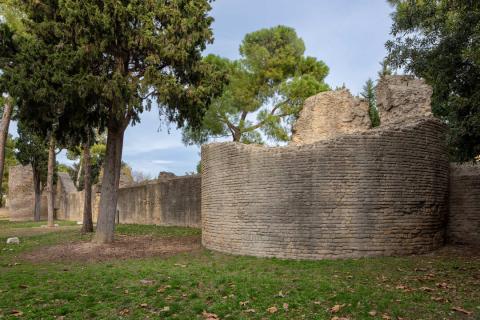In 9 AD Emperor Caesar Octavian Augustus, in the grandiose project of monumentalization of the city, completes the construction of the perimeter walls that embrace and defend the Colonia Julia Fanestris. Built largely following the indications provided by Vitruvius in his "de Architettura", the Augustan Walls of Fano still constitute one of the best preserved city walls after those of Rome and represent one of the most evocative and significant testimonies of the city's glorious past.
Originally 1760 meters long, the Augustan Walls of Fano, commissioned by Emperor Caesar Octavian Augustus as part of the ambitious monumentalization project of the Colonia Julia Fanestris, were completed in 9-10 AD, as evidenced by the inscription on the frieze of the Arch of Augustus, and are among the best preserved in Italy.
In their structure we find many construction dictates provided by Vitruvius in De Architettura, further confirming that the architect had a notable influence on the urban design of the city. In fact, the Walls were built entirely with the masonry technique of opus vittatum, listed work, i.e. rows of sandstone of different heights arranged horizontally for the external part and of opus cementicium, a conglomerate of mortar and flakes, for filling internal, as indicated in the famous treaty for the construction of defensive structures.
The wall circuit, which follows the course of the river terrace on which the city stands, is still preserved today for approximately two thirds of the original circuit: it is divided into long sections of wall interspersed with 28 cylindrical towers "an arrow's throw" away one from the other and two access gates: in addition to the well-known Porta d'Augusto, about halfway up the Roman walls there is a smaller access gate to the city called Porta della Mandria since flocks grazed there in the past. The Porta della Mandria had the function of allowing the Flaminia to leave the city to head north and reach Pisaurum, now Pesaro.
Today a large stretch of the original perimeter is still visible, while the rest of the walls suffered serious damage during the Greek-Gothic war first, and on the occasion of the expansion of the city wanted by the lord of Rimini and Fano Sigismondo Pandolfo Malatesta, during the 14th- Then the 15th century. During this second intervention, a large part of the Roman city wall was destroyed and the Porta Maggiore was built in front of the Arch of Augustus, to the west of the city. Subsequently, the curtain walls were saved from demolition in the 1920s, a period in which it was intended to encourage the urban development of the city and only afterwards did their valorization as a historical asset begin.
Today the Augustan walls are one of the most evident and best preserved traces of the ancient origins of the city and allow you to take a long journey back in history following in the footsteps of Vitruvius.
